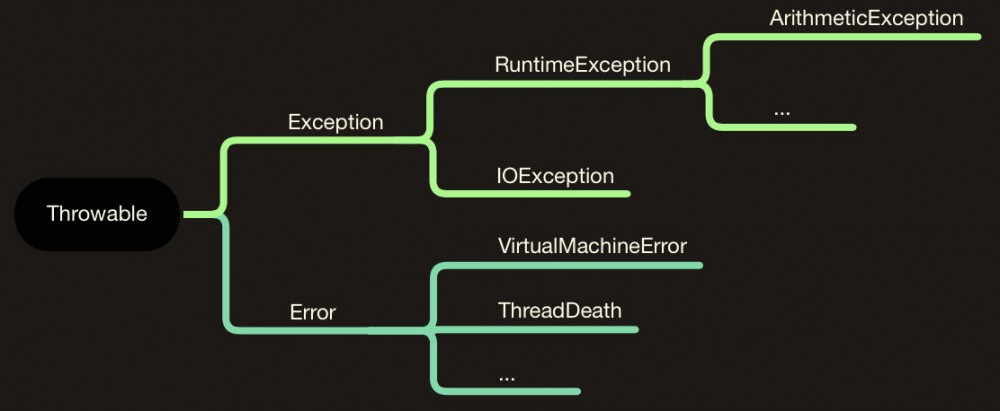别扯那些没用的系列之:Java异常
先来一起看看下面的代码:
package com.huangzx.Exception;
/**
* @author huangzx
* @date 2018/11/27
*/
public class ExceptionTypeTest {
public class ExceptionTypeTest {
public int doSomething() throws ArithmeticException {
return 5 / 0;
}
public static void main(String[] args) {
ExceptionTypeTest ett = new ExceptionTypeTest();
ett.doSomething();
}
}
复制代码
问:上面的代码能编译通过吗?
答:可以。ArithmeticException是RuntimeException异常,可以不进行捕获或抛出。 如果改为IOException,如下:
package com.huangzx.Exception;
import java.io.*;
/**
* @author huangzx
* @date 2018/11/27
*/
public class ExceptionTypeTest {
public void doSomething() throws IOException {
InputStream is = new FileInputStream(new File("/Users/huangzx/test.txt"));
is.read();
}
public static void main(String[] args) {
ExceptionTypeTest ett = new ExceptionTypeTest();
ett.doSomething();
}
}
复制代码
问:它还能编译通过吗?
答:不能。IOException是直接继承自Exception的异常,它必须得到处理,要么捕获要么抛出。
受检异常和非受检异常
上面两个例子中,ArithmeticException与IOException都是来自Exception体系,为什么一个不需要处理,一个需要处理呢?这就涉及到两个概念:受检异常和非受检异常。 先来复习一下Java异常体系:

- 非受检异常:RuntimeException及其子类。这类异常由程序员逻辑错误导致,应该人为承担责任。Java编译器不要求强制处理,即可以捕获或抛出,也可以不捕获或抛出。
- 受检异常:非RuntimeException异常。这类异常是由于外部的一些偶然因素引起的。Java编译器要求强制处理,即必须得到捕获或抛出。
两者的代表人物出场(掌声有请~~):
- 非受检异常:RuntimeException,ArithmeticException,NullPointerException,ClassCastException,ArrayIndexsOutOfBoundsException
- 受检异常:Exception,IOException,SQLException,FileNotFoundException
如何处理异常
既然两者的概念清晰了,处理方式也随之昭然若揭。
针对受检异常:
- throws抛出。(这是低端做法)
- try/catch捕获处理。(推荐之,高端做法)
针对非受检异常:
- throws抛出。
- try/catch捕获处理。
- 不处理。(这个就厉害了,我才不管程序崩没崩,把锅甩给上帝~~)
自定义异常
以上是打基础,下面玩点高级的。
当需要一些跟特定业务相关的异常信息类时,我们可以在Java自身定义的异常之外,编写继承自Exception的受检异常类,也可以编写继承自RuntimeException或其子类的非受检异常类。
一般情况下,异常类提供了默认构造器和一个带有String类型参数的构造器。我们的自定义异常,只需要实现这两个构造器就足够用了。因为最有价值的是我们定义的异常类型(即异常的名字),当异常发生时,我们只要看到了这个名字就知道发生了什么。所以除非有一些特殊操作,否则自定义异常只需简单实现构造器即可。
示例:
1、自定义业务异常类,继承自RuntimeException。
package com.huangzx.Exception;
/**
* @author huangzx
* @date 2018/11/27
*/
public class BusinessException extends RuntimeException {
private String code; // 异常返回码
private String msg; // 异常信息
public BusinessException() {
super();
}
public BusinessException(String message) {
super(message);
this.code = code;
}
public BusinessException(String code, String msg) {
super();
this.code = code;
this.msg = msg;
}
public String getCode() {
return code;
}
public String getMsg() {
return msg;
}
}
复制代码
2、定义方法,声明throws这个自定义异常。要使用它,必须通知调用代码的类,做好“抱接”这个异常的心理准备。代码逻辑中异常发生的点,需要throw抛出。
public void logicCode() throws BusinessException {
throw new BusinessException("-1000", "业务出错");
}
复制代码
3、测试自定义异常main方法
public static void main(String[] args) {
ExceptionTest et = new ExceptionTest();
try {
et.logicCode();
} catch (BusinessException e) {
e.printStackTrace();
System.out.println("code=" + e.getCode() + "msg=" + e.getMsg());
}
}
复制代码
基本上,就差不多了。另外还有一个需要注意的点,就是:千万不要在finally再抛出一个非常规异常,因为它必定会执行,导致你try{}监测的代码块捕获的异常得不到处理,会起到混淆视听的效果,让你排查问题时摸不着头脑,请切记。示例如下:
package com.huangzx.Exception;
/**
* @author huangzx
* @date 2018/11/27
*/
public class ExceptionLoseTest {
public static int throwException() throws Exception {
try {
throw new Exception();
} catch (Exception e) {
throw e;
} finally {
throw new NullPointerException();
}
}
public static void main(String[] args) {
try {
throwException();
} catch (Exception e) {
e.printStackTrace();
}
}
}
复制代码
执行结果如下:
java.lang.NullPointerException at com.huangzx.Exception.ExceptionLoseTest.throwException(ExceptionLoseTest.java:14) at com.huangzx.Exception.ExceptionLoseTest.main(ExceptionLoseTest.java:20) 复制代码











![[HBLOG]公众号](https://www.liuhaihua.cn/img/qrcode_gzh.jpg)

